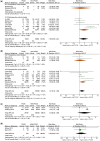Long-term cardiometabolic disease risk in women with PCOS: a systematic review and meta-analysis
- PMID: 32995872
- PMCID: PMC7600286
- DOI: 10.1093/humupd/dmaa029
Long-term cardiometabolic disease risk in women with PCOS: a systematic review and meta-analysis
Abstract
Background: Polycystic ovary syndrome (PCOS) is associated with cardiometabolic disease, but recent systematic reviews and meta-analyses of longitudinal studies that quantify these associations are lacking.
Objective and rationale: Is PCOS a risk factor for cardiometabolic disease?
Search methods: We searched from inception to September 2019 in MEDLINE and EMBASE using controlled terms (e.g. MESH) and text words for PCOS and cardiometabolic outcomes, including cardiovascular disease (CVD), stroke, myocardial infarction, hypertension (HT), type 2 diabetes (T2D), metabolic syndrome and dyslipidaemia. Cohort studies and case-control studies comparing the prevalence of T2D, HT, fatal or non-fatal CVD and/or lipid concentrations of total cholesterol (TC), low-density lipoprotein cholesterol (LDL-C), high-density lipoprotein cholesterol (HDL-C) and triglycerides (TGs) between women with and without PCOS of ≥18 years of age were eligible for this systematic review and meta-analysis. Studies were eligible regardless of the degree to which they adjusted for confounders including obesity. Articles had to be written in English, German or Dutch. Intervention studies, animal studies, conference abstracts, studies with a follow-up duration less than 3 years and studies with less than 10 PCOS cases were excluded. Study selection, quality assessment (Newcastle-Ottawa Scale) and data extraction were performed by two independent researchers.
Outcomes: Of the 5971 identified records, 23 cohort studies were included in the current systematic review. Women with PCOS had increased risks of HT (risk ratio (RR): 1.75, 95% CI 1.42 to 2.15), T2D (RR: 3.00, 95% CI 2.56 to 3.51), a higher serum concentration of TC (mean difference (MD): 7.14 95% CI 1.58 to 12.70 mg/dl), a lower serum concentration of HDL-C (MD: -2.45 95% CI -4.51 to -0.38 mg/dl) and increased risks of non-fatal cerebrovascular disease events (RR: 1.41, 95% CI 1.02 to 1.94) compared to women without PCOS. No differences were found for LDL-C (MD: 3.32 95% CI -4.11 to 10.75 mg/dl), TG (MD 18.53 95% CI -0.58 to 37.64 mg/dl) or coronary disease events (RR: 1.78, 95% CI 0.99 to 3.23). No meta-analyses could be performed for fatal CVD events due to the paucity of mortality data.
Wider implications: Women with PCOS are at increased risk of cardiometabolic disease. This review quantifies this risk, which is important for clinicians to inform patients and to take into account in the cardiovascular risk assessment of women with PCOS. Future clinical trials are needed to assess the ability of cardiometabolic screening and management in women with PCOS to reduce future CVD morbidity.
Keywords: cardiometabolic health; dyslipidaemia; hypertension; long term; meta-analysis; polycystic ovary syndrome; systematic review; type two diabetes mellitus.
© The Author(s) 2020. Published by Oxford University Press on behalf of European Society of Human Reproduction and Embryology.
Figures




References
-
- Andersen M, Glintborg D. Diagnosis and follow-up of type 2 diabetes in women with PCOS: a role for OGTT? Eur J Endocrinol 2018;179:D1–D14. - PubMed
-
- Azziz R, Carmina E, Dewailly D, Diamanti-Kandarakis E, Escobar-Morreale HF, Futterweit W, Janssen OE, Legro RS, Norman RJ, Taylor AE et al. The Androgen Excess and PCOS Society criteria for the polycystic ovary syndrome: the complete task force report. Fertil Steril 2009;91:456–488. - PubMed
-
- Bell KJL, Bossuyt P, Glasziou P, Irwig L. Assessment of changes to screening programmes: why randomisation is important. BMJ 2015;350:h1566. - PubMed
Publication types
MeSH terms
Substances
LinkOut - more resources
Full Text Sources
Other Literature Sources
Medical
Miscellaneous

